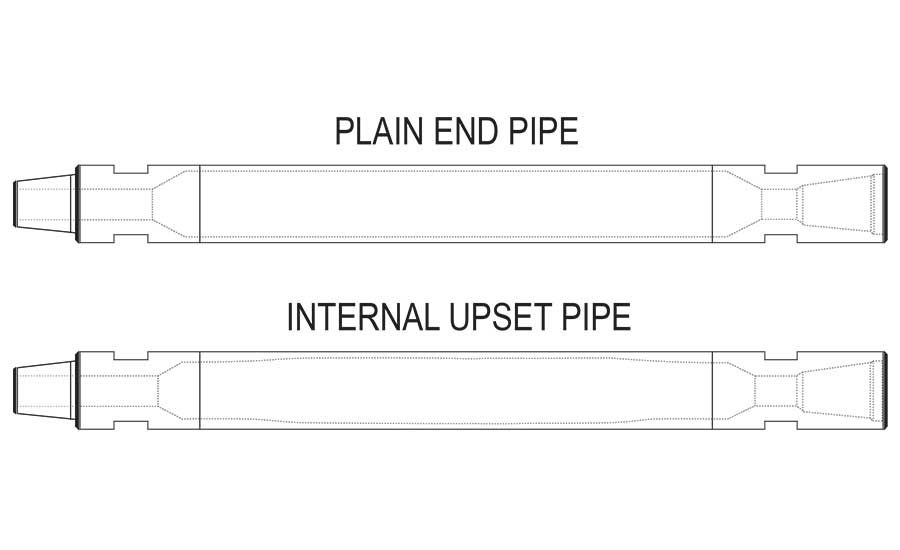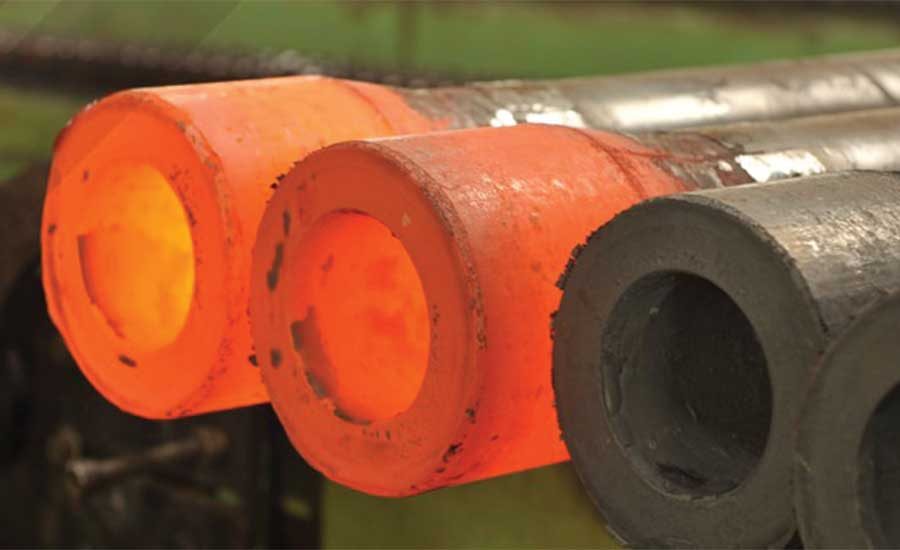For Deep Drilling Jobs, Is Upset Drill Pipe Needed?



Tubes glow after coming out of an upsetter. Upset drill pipe can come with a 10 to 20 percent cost increase. Source: David King



If you are running conventional oilfield drill pipe, drilling deep with a mud rotary or perhaps drilling 5,000 feet for natural gas with flush joint drill pipe, then you are familiar with the term “upset.” Sometimes elevator-shouldered drill pipe, where the tool joints are larger in diameter than the tubes, is referred to as upset drill pipe. In reality, drill pipe is considered upset when the tubes are upset prior to welding.
As we all know, a drill pipe typically consists of a tube with a rod end (tool joint) welded on each end of the tube. In water well applications, the tool joints are welded to the tubes as they are. This is sometimes called “straight wall” or “plain end” welded. In this application, drill pipe is usually assumed to be welded this way unless it is specified to be upset.
In oilfield applications using conventional drill pipe an upset is expected, especially if it follows guidelines by the American Petroleum Institute (API). In this article, I will talk about drill pipe being utilized in water well and other applications under 5,000 feet.
So, What is Upsetting?
Upsetting is a forging process that makes for a thicker wall on the tube ends. The tube ends are heated to a near liquid state. The heated end is then placed in the upsetter machine and held in a clamp. The machine is engaged and it strikes the end of the tube with so much force that the metal flows backward a couple of inches. The exact new wall thickness and the location of this extra metal is set depending on which die and punch are placed in the upsetter. The die controls the outside shape and the punch determines the inside shape.
Most upsetters being used in the manufacture of this type of drill pipe are huge mechanical beasts. They can weigh over a couple hundred thousand pounds and are set on complicated complex foundations. The punch is attached to the traveling head which, in itself, is quite massive. I would recommend watching one of these beasts smack those hot tube ends to experience the sights, smells and vibrations to get a proper feel of the process.
If all the extra material is on the outside, it is an external upset (EU). If all the extra metal is on the inside, it is called an internal upset (IU). A tube can have both an EU and an IU — a combination called an internal-external upset (IEU). Sometimes it takes two hits (strikes) to form the IEU.
Once upset, the tubes should be full-body heat treated to grade. Most companies with upsetters have their own heat treatment equipment to bring those tubes up to grade. This post-upset heat treatment is a vital part of the upsetting process and the overall costs. So, upsetting provides for a thicker tube at the tube ends and the flow of metal provides a gentle radius back to the original wall thickness. Upsetting is also used in the HDD drill pipe industry to produce the integral drill pipe used on the smaller HDD rigs.
Advantages to Upset Drill Pipe
Statistically speaking, whether a drill pipe is upset or not has no bearing on the tube’s ultimate tensile strengths. These are still determined by the tube body. So why bother? Upsetting provides two main advantages. It provides for a thicker, stronger weld area. It also provides a better transition from the stiffer tool joints to the more flexible tubes. It moves the stressed areas away from the weld zone. As you know, sudden changes in material thickness can be a gathering point for stress.
So why aren’t all drill rods upset? It comes down to need and cost. Upsetting is not only expensive to operate, but typically not a fun thing for manufacturers. Great to watch, not great to fund. Upsetters are expensive to fix. Having in-house heat treating to process the tubes after upsetting is also really expensive. Some drill pipe manufacturers for this industry will job out the upsetting and heat treatment operations, and some will purchase tubes already processed from the steel mill. You can’t beat in-house capabilities for turnaround and flexibility.
When is Upset Drill Pipe Recommended?
Elevator-shouldered drill pipe is where the tool joints are larger than the tube. Here, I personally like the upset for depths more than 750-1,000 feet, or in difficult drilling situations. In this design, tool joints are much larger, stronger and stiffer than the tubes, and all those drilling stresses are pushed back to the tube and weld areas.
For flush-joint drill pipe, we would use the internal upset or IU. In my opinion, for flush-joint drill pipe, the IU should be considered when drilling over 2,000 feet in depth, strongly considered for jobs of more than 3,000 feet, and a definite need for projects deeper than 4,000 feet. Although non-upset flush-joint drill pipe has successfully drilled deeper than 5,000 feet, risks increase with depth and the demands it puts on the drill pipe. Drilling conditions and hole size are also important, as difficult conditions and/or large diameter holes can add stress to the drill pipe.
If a product description of drill pipe does not say upset (IU, EU or IEU), then it probably is not upset. When seeking pricing, if you think you might want an upset, ask for it or ask for both upset and plain end (PE) product quotes to compare costs. An IU can add 10 to 20 percent to the cost of the drill pipe. Is it right for your application?
Looking for a reprint of this article?
From high-res PDFs to custom plaques, order your copy today!









